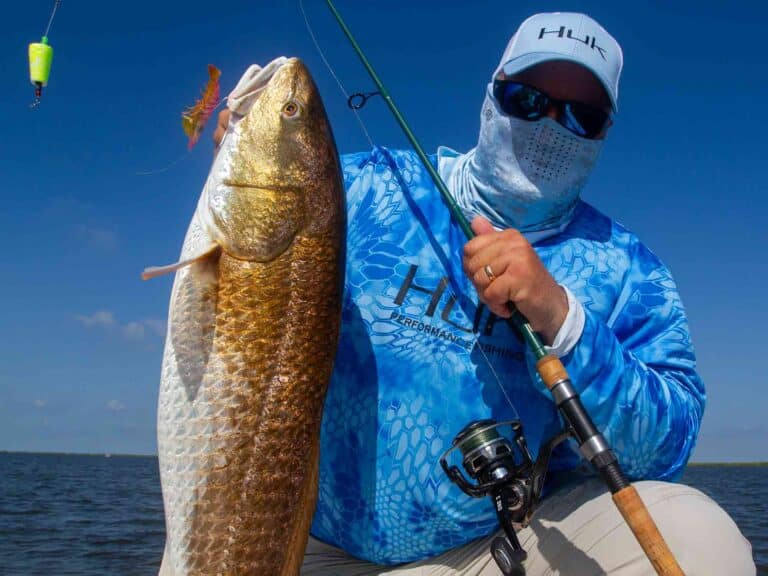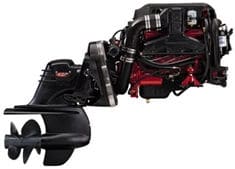
| Volvo Penta’s award-winning Ocean Series sterndrives feature composite-encased outdrives for improved durability and corrosion protection. |
Four-stroke outboards have been in the spotlight recently, but they’re not the only news in marine power. There are also changes afoot in that niche between the outboard and the inboard. Known by a few different names – inboard/outdrive, inboard/outboard, I/O, sterndrive – it’s the same animal: a marine inboard engine coupled to a transmission/gear housing that mounts on the transom.
Sterndrives have long been offered as an option by some boatbuilders – e.g., Carolina Classic and Albemarle – but for many others it’s a new frontier. Advantages of the system, coupled with recent improvements, are drawing a lot of attention, and rightly so.
The advantages of I/O power are many. Economy is one, since power comes from a four-stroke or diesel inboard engine. I/Os are very maneuverable, too. The outdrive swivels at the transom to direct the thrust, so it’s as nimble as an outboard.
Disadvantages? Corrosion and electrolysis have been problems for I/Os. That’s because you can’t raise the outdrive out of the water as far as you can an outboard. This is not so critical in cold climates, where the drive unit is only submerged for four or five months a year, but in warmer places with a year-round season you have to keep an eye on it. Another disadvantage has been the relatively high initial cost compared to traditional two-stroke outboard power.
Worth the Price
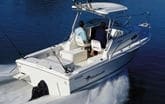
Sterndrives combine the best features of outboard and straight-inboard applications, including improved maneuverability and the option of diesel power. |
Enter the sea change. With the advent of high-power, four-stoke outboards whose prices approach that of a new car, suddenly the sterndrive option is not substantially more costly. And the efficiency is superb. Lastly, improvements in metallurgy, coatings and design have addressed the corrosion problems of the past, and have largely overcome them.
First to offer an entire I/O drive-train designed specifically for salt water is Volvo Penta with its Ocean Series. This new line won the National Marine Manufacturers Association’s Innovation Award in the Engines Category at the Miami International Boat Show this past February. The Innovation Award, which is the highest honor for product excellence, is measured by its overall benefits to the marine consumer.
These benefits are, first of all, a non-corrosive, composite shell on the outdrive. The composite material encases the drive’s metal housing, still necessary to handle the torque created by the system, and eliminates corrosion. Additionally, the redesigned Ocean system incorporates an add-on engine-flushing kit that that squirts a dose of salt neutralizer/corrosion inhibitor into the raw-water cooling system. It’s no longer necessary to flush the cooling system with fresh water at the end of the day.
What was the impetus for developing an all-new system aimed at the marine angler? “Six years ago, a number of us felt there had to be a better mousetrap for salt water fishermen. Some of us remember when fishing boats had a transom to fish from, and we felt we could return that to the fisherman,” explained Clint Moore, president and CEO of Volvo Penta of the Americas. “In developing the series, we felt that a lot of the resistance to the sterndrive in salt water was more a problem of perception, based on problems experienced with the first sterndrives years ago. To counter this, we developed the composite drive, so that we would be addressing the problems in a way everyone would recognize. This required some heavy-duty pioneering in the gimbal ring, where the drive meets the transom. This we did successfully.”
At the same time, Moore explained, Volvo felt it could supply the performance – from wide-open throttle to low-speed trolling – which would match anything on the market. “We knew that lowest possible operating costs are important, and we are confident we can provide that as well,” he said.
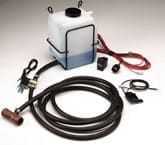
The Ocean Series’ built-in flushing system uses a biodegradable salt neutralizer that eliminates the need to flush the cooling system with fresh water at day’s end.|
Currently, the Ocean Series is available from 225 to 320 horsepower, with gasoline engines. But Volvo may not be done yet. “Our Ocean Series is capable of handling substantially more power, or diesel power, should we feel there is a market for it,” Moore said.
MerCruiser Moves
Another big player in the sterndrive game is MerCruiser. It’s latest offering is a 1.7-liter, direct-injected diesel that falls in the 120-hp range, and is already providing economy and performance on a variety of smaller fishing boats when coupled with the MerCuriser Alpha Drive, according to Steve Shroderer, Business Development Manager for Mercury Marine. “We’ve put this combination in a 26-foot runabout,” he said, “and we’re doing 30 mph with four people onboard. Cruising at 80-percent throttle, it burns four gallons an hour.”
Shroderer stresses that a lot of the early problems associated with using sterndrives in salt water have been eliminated. Protection of the metal parts has been improved via electric deposition plating, an electronic painting system. Components are also likely to have ceramic coatings, and low-carbon 316 stainless steel – the same alloy used in food handling – has become much more available and cheaper, and provides much better corrosion resistance than other alloys.
Recently, Mercury announced a joint venture with Cummins Marine, and while the initial results of this liason will provide Mercury with access to the inboard market, the matching of outdrives to Cummins engines is only a matter of time. When we spoke with Shroderer, he was at Lake X, the Mercury test site, supervising the launch of a 38-foot Donzi equipped with sterndrives and 575-hp engines. It’s clear that Mercury is well into pushing the current limits of sterndrive technology.
Diesel-Powered I/Os
A lot of successful development is taking place with diesel engines that goes beyond the experimental stage. Jupiter Marine in Fort Lauderdale, Florida, recently introduced a 31-foot boat powered by a Yanmar engine coupled to a MerCruiser sterndrive. It’s finding a surprisingly eager group of customers.
According to Jupiter president Carl Herndon, the traditional objection to sterndrives – that of corrosion vulnerability – is largely one of perception. But right or wrong, he says it hasn’t been an issue for his customers, who usually keep their boats on lifts or trailers. Currently, Jupiter offers the 31 with diesel power up to 315 hp. Larger than that and you have to go with a bigger, heavier engine block. According to Herndon, the 315-hp setup pushes the 31 at a solid 30 knots, loaded, while burning seven gallons of fuel per hour. “For the guy who fishes offshore, this is great,” he says.
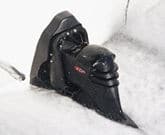
The new gimbal ring on the Ocean Series line is made of a composite material to help combat corrosion.|
In developing the 31 Diesel, Jupiter worked closely with Mastry Engine Center in St. Petersburg, Florida, where Adib Mastry is the acknowledged sterndrive expert. Nine years ago he patented the link between the MerCruiser outdrive and Yanmar diesel engines, and this package – the same configuration he helped Herndon put in the Jupiter – makes up the bulk of Mastry’s sterndrive installations.
Recently, Mastry put a sterndrive on a Sea Craft 32 and gained the same performance: 3.5 mpg at 37 mph. Since putting the first boat together, he has sold a couple of them to people who were weren’t even looking to make the switch from outboard to I/O.
Mastry sees several reasons for the renewed interest in I/O power in salt water. “In the first place,” he says, “sterndrives have gotten better over the last few years, and a lot of the concerns, such as corrosion, have been addressed. The equipment is better, too.
“For example, the 315-hp 6LP Bravo IIIX that MerCruiser created for the model year 2001 is greatly enhanced. It has bigger U-joints and cryogenically hardened gears, and has proven to be very reliable. We put out 160 sterndrives with the 6LP last year and had a minimal failure rate.”
In addition to being reliable, sterndrive power is clean and economical. “People are becoming more conscious of the amount of fuel burned by outboards,” says Mastry, “and the fact that there is so much oil going into the environment. We can put out boats that have outstanding fuel economy and range, and do it much cleaner than any of the outboards on the market.”
Diesel sterndrive power also works out to be very economical, according to Mastry. “With the development of four-stroke outboards and the prices they have been selling for, we found that we can supply a 250-hp diesel sterndrive for the same price as a 225-hp, four-stroke outboard.”
Save Fuel, Space

The Jupiter 31 couples a Yanmar engine with a MerCruiser sterndrive, and is available with diesel power up to 315 hp. |
Mastry explained that the range and fuel economy of diesel sterndrives aren’t even in the same ballpark as outboards. “With a 250-horse outboard, cruising at 35 mph, we are getting just under one mile per gallon. With 300 gallons of fuel, that’s a 270-mile range. If we power the same boat with a diesel sterndrive, with a cruising speed of 35 mph, we get almost four miles to the gallon and a range of over 900 miles.”
Mastry has also developed an improved driveshaft, which plays a vital role in fishing boats. By incorporating a driveshaft, or jackshaft, the engine can be placed farther forward, under the console, eliminating the traditional engine box from the cockpit. It’s a big space saver.
“We are using high-speed CV joints on our jackshaft,” says Mastry. “I got the idea from a Cadillac El Dorado. The demands on the front drive axle are similar to those on the jackshaft. And it runs with a lot less vibration if you use CV joints instead of the customary U-joints.”
The limits are continually being pushed in sterndrive development. Mercury Racing is producing a No. 6 Speedmaster drive that handles up to 460 hp. At the Bravo Shop in Fort Myers, Florida, Dean Clausen’s B-Drive is built over the MerCruiser Bravo XR to handle up to 1,000 hp. Granted, it’s a specialty item designed for racing and military applications, but sooner or later the technology will filter down to the consumer. Experi-mental technology today is the fish-boat technology of tomorrow. And all of a sudden there’s a lot happening in the sterndrive world.
| Sterndrive Information****Volvo Penta, (757) 436-5119; www.volvopenta.comMerCruiser, (800) MERCURY; www.mercurymarine.com |






